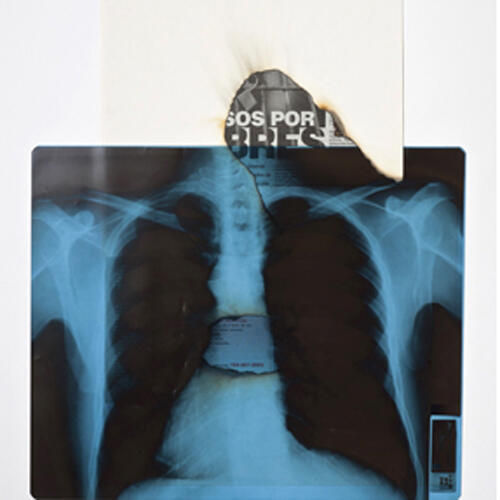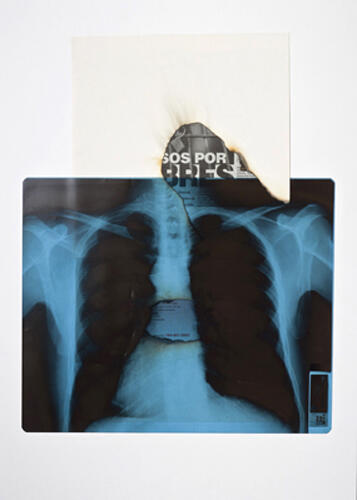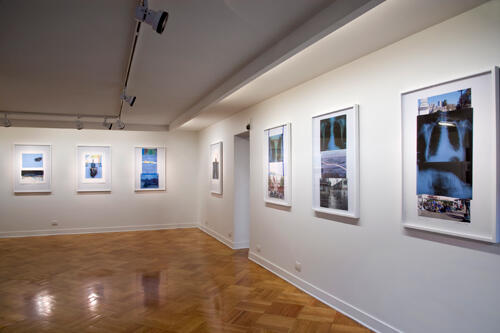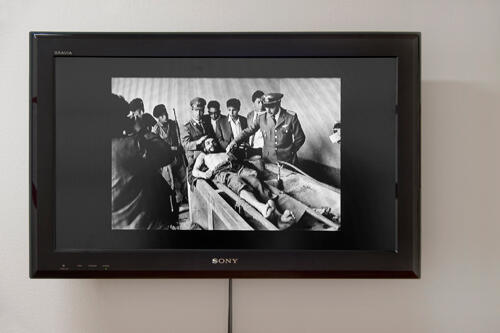Catalina Parra y Leandro Katz´s
meet up at the Galería D21, Chile
The Chilean artist Catalina Parra and the Argentinean artist Leandro Katz unite their autonomous proposals at the D21 Gallery, in Chile, where they remained until October 8. They both have wide career and have focused on the problems of contemporary visualise, as well as showing that a strong social compromise to Latin American realities.

The independent proposals of Catalina Parra and Leandro Katz present important coincidences. Generationally close, they both started their career in a troubled time that demanded a social and critical compromise from creators, dominating the artistic exercise of an experimental character. This choice enriched during a long period in which they both lived in New York, where they developed an important part of their careers.
Catalina Parra (1940) is a recognized Chilean artist, self-made, who is self-taught, Nicanor Parra poet’s daughter. From the 70s she develops a prolific work of complex visual operations incorporating various languages, such as video, objects, found materials, photography, and newspaper clippings. Along with that, she has also realized urban intervention using the advertising media. Catalina Parra lived in Germany from 1968-1972. In 1980, she travelled to New York with the help of the Guggenheim scholarship and she remained there until 2000. Then she moved to Buenos Aires to assume as Cultural Attaché of Ricardo Lagos’ government, and stayed there until 2009.
Her artistic production that contemplates a diverse imaginary and her visual strategy is characterizes by the juxtaposition of different semiotic levels, using materials extracted from the press, advertising, and other mass media that incite consumerism and the solidification of the status quo. The artist has worked profusely with these works, which she cuts and fragments in order to reassemble them with basting and seams. In this way, her work uses the rhetoric of the mass media that she compares to the craft of sewing; she disarticulates official and unified reasoning, questioning the legibility that they impose on us.
The sewing issue background in her work can be found in her memorable exhibition "Imbunches", which she completed in 1977, and where she used a joint inspired in the myth of “Chilote del Imbunche”, which talks about a man that has all the holes in his body sewn up so that the spirit of evil doesn’t leave him. Through sewing, the artist references the violence and repression that was the product of the military dictatorship in Chile at that moment.
At D21 Gallery, she will present works from a series that crosses images of different scopes: images that register situations that the artist had to live, with during her stay in Argentina, such as the manifestations at the Plaza de Mayo, from the “piqueteros”, and photographs that she took of homeless individuals sleeping in the streets. Along with these images, we see radiographies of intoxicated lungs, maps, newspaper fragments, and her characteristic seams. In this way, continuing her poetry, the artist provokes us with these works, stressing the referential images and forcing a new reading of them.
The Argentinean artist Leandro Katz (1938) is a visual artist, poet, and filmmaker. In this exposition he presents the documentary-styled videos The day you love me (El día que me quieras) and “Exhumation” (Exhumación), both inspired in the tragic death of Ernesto Che Guevara in Bolivia in 1967. The video, The Day you Love Me came out of the artist’ interest in the photograph where was Ernesto Che Guevara lies dead over a cement surface, surrounded by the Bolivian soldiers that captured him. The movie is focus on an interview of the man who took the photograph, Freddy Alborta. The documentary interposes the interview with photographs, newspaper headings, and sequences shot in the Bolivian regions of La Higuera and Ilabaya, where a group of natives are realizing a carnival in tribute to Che Guevara. The video begins with a voice reading a text based on “The Witness” by Jorge Luis Borges, which narrates the solitary death of a man inside a stable. The title of the video, The Day You Love Me alludes to a song by Carlos Gardel, which also forms part of the music of the video.
The video Exhumation, on its part, is an interview with the forensic doctor Alejandro Incháurregui, who, along with a crew composed of investigators and anthropologists, was in charge of finding the remains of q Ernesto Che Guevara and his companions in Bolivia in 1997. In the documentary, the doctor relates their attempts to find Che Guevara’s body through details provided by Mario Vargas Salinas, a retired general of the Bolivian Armed Forces. The interview also gives details of the finding of Tania’s body, a guerrilla woman, as well as of the international fetish market that the Bolivian soldiers produced, when they took over and started selling the personal belongings of the victims of the guerrilla of Ñancahuzú, and photographs taken by the guerrilla men during Che’s campaign in Bolivia. Along with these videos, the artist presents “Chronology of the Campaign of Ernesto Che Guevara in Bolivia", which consist of mural texts that relate through different voices the tragic final campaign of Che Guevara.
Leandro Katz lived in New York between 1965 and 2006, where he led academic and creative initiatives. In his works, he made researches that include historical, artistic, and anthropological aspects. Throughout his creation, he has produced different types of works, such as photograph installations, artist’s books, and both documentary and fictional films. For his work, Katz has received a Guggenheim scholarship, and from the National Endowment for the Arts, New York State Council on the Arts, Jerome Foundation, Rockefeller Foundation and the Hubert Bals Fond from Holland, among others. He has published various works, the most recent one, “The Ghosts of Ñancahuazú" was edited by Proa Foundation in Buenos Aires, where he has lived since 2005.
www.departamento21.cl
-
 Catalina Parra, Cromagnon, 2008. Mixed / Técnica mixta, 70 x 100 cm.
Catalina Parra, Cromagnon, 2008. Mixed / Técnica mixta, 70 x 100 cm.
Courtesy/Cortesía: Departamento 21 -
 Catalina Parra, Banderitas Argentinas, 2007. Mixed / Técnica mixta, 70 x 100 cm.
Catalina Parra, Banderitas Argentinas, 2007. Mixed / Técnica mixta, 70 x 100 cm.
Courtesy/Cortesía: Departamento 21 -
 Catalina Parra, Installation view / Vista general.
Catalina Parra, Installation view / Vista general.
Courtesy/Cortesía: Departamento 21 -
 Leandro Katz, El día que me quieras (detalle), 1997. 16 mm Film transferred to DVD / Película 16 mm transferida a DVD, 29´50´´
Leandro Katz, El día que me quieras (detalle), 1997. 16 mm Film transferred to DVD / Película 16 mm transferida a DVD, 29´50´´
Courtesy/Cortesía: Departamento 21 -
 Leandro Katz, Installation view / Vista General Exposición.
Leandro Katz, Installation view / Vista General Exposición.
Courtesy/Cortesía: Departamento 21




